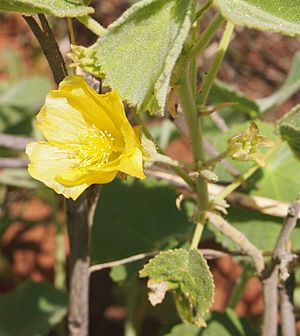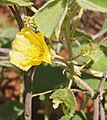Desert lantern facts for kids
Quick facts for kids Desert lantern |
|
|---|---|
 |
|
| Abutilon otocarpum flower | |
| Scientific classification | |
| Genus: |
Abutilon
|
| Species: |
otocarpum
|
The desert lantern (Abutilon otocarpum) is a cool little shrub that grows in many parts of Australia. It belongs to the Malvaceae family, which also includes cotton and hibiscus plants! This plant gets its common name, "desert lantern," because its yellow flowers look a bit like small lanterns hanging in the dry landscape.
Contents
Discover the Desert Lantern Plant
The desert lantern is a small shrub, usually growing up to 60 centimeters (about 2 feet) tall. Its leaves are flat and grow one after another along its stem.
What Do Its Leaves and Flowers Look Like?
The leaves of the desert lantern can be anywhere from 1.5 to 6 centimeters long. They can be narrow or round, and they often feel a bit hairy. The edges of the leaves are also slightly toothed.
The flowers are bright yellow and have five petals. You'll usually find them growing alone on small stalks. These stalks come out from where the leaves meet the stem. Sometimes, the flowers look like they are grouped together at the ends of the branches.
How Is It Different from Other Plants?
The desert lantern is part of a big family of plants called Abutilon. It has some special features that help tell it apart from its relatives. For example, its petals are about the same length as the green cup-like part (called the calyx) that holds the flower. Also, the small fruit parts (called fruitlets) have very short points on top.
Where Does the Desert Lantern Grow?
This tough little shrub grows wild in many different climates across Australia. You can find it in places that are warm and dry, like semi-arid areas. It loves sandy soils and often grows on sand dunes or low sandy hills.
Its Favorite Places to Live
The desert lantern is happy in many dry spots. It grows on sandy plains, in dunefields, and even on fertile plains where rivers sometimes flow. You might also spot it near rocky or gravelly hills. It's a plant that's well-suited to Australia's drier regions.
How People Use the Desert Lantern
Even though it grows in tough conditions, the desert lantern has been useful to people for a long time.
Traditional Uses by Aboriginal People
Aboriginal people, the first Australians, used the desert lantern in many ways. They would get a strong fiber from the bark of the stem. This fiber could be used for different things, though we don't know if it's still used today.
The plant also provided food. Some groups, like the Pintupi Luritja and Pitjantjatjara people, ate the fruit flesh. The Pitjantjatjara and Warlpiri people also used the plant's gum and other parts as food for animals.
Beyond food, the desert lantern was important for other cultural uses. It could provide shade or shelter, and parts of it were even used to make toys or tools like spears and fish traps.
Growing the Desert Lantern
If you wanted to grow a desert lantern, it would need a spot with lots of sunshine or at least some shade during the day. It also likes soil that is rich and drains water well. A cool thing about the desert lantern is that it can flower for most of the year!
Aboriginal Names for the Desert Lantern
Different Aboriginal language groups have their own names for the desert lantern. These names show how important the plant is to their culture and knowledge.
- Alyawarr: akeley-akeley, anteyterrk, arlpart, aylpart
- Anmatyerr: akeley-akeley
- Pintupi Luritja: tatji-tatji
- Pitjantjatjara: tjirin-tjirinpa
- Warlpiri: jinka-jinka, taji-taji
Images for kids


